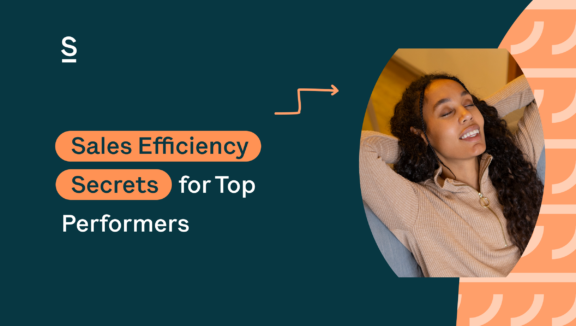5 Sales Efficiency Secrets for Top Performers

Sales efficiency is a necessity for SDRs striving for the top. Mastering sales efficiency does not mean just working harder; it involves working smarter by leveraging lesser-known strategies and tools that can significantly boost performance. It’s getting more from less.
Working daily with the best sales teams globally, we’ve had the chance to collect their secrets for refining sales efficiency and effectiveness. These are strategies that set them apart from the competition and will set you apart from the competition when you apply them.
Key highlights:
Secret #1: Using Advanced CRM Customization Techniques
Your CRM is the backbone to your success. Your sales depend on your relationship with your prospects and your CRM is how you track and maintain so many relationships. However, the real magic lies not just in using these systems but in customizing them to fit the intricate needs of your sales process. Advanced CRM customization goes beyond the basic use of these platforms, tapping into their full potential to automate and streamline your sales workflows in ways that dramatically increase sales efficiency.
Exploring deep CRM customization begins with understanding the capabilities of your CRM platform. Many popular CRMs, such as Salesforce, HubSpot, and Pipedrive, offer a wealth of features that remain underutilized. These can include custom fields, personalized workflow automation, and advanced reporting that, when properly utilized, can provide insights and efficiencies previously unattainable. For instance, by creating custom fields tailored to your sales process, you can capture and analyze data relevant to your specific sales strategy, leading to more informed decision-making.
Implementing custom workflows is where the customization truly shines. Most CRMs allow you to create automated workflows that can take care of routine tasks without human intervention. For example, you can set up a workflow to automatically send a follow-up email a few days after a sales call, assign tasks to team members based on lead status changes, or even score leads based on their interaction with your emails and website. These automated workflows ensure that no lead falls through the cracks and that your team can focus on the most promising prospects.
But how do you ensure sales efficiency through CRM optimization? First, it’s crucial to regularly review and refine your CRM setup. Sales processes evolve, and your CRM should evolve with them. This might involve periodically reviewing your automated workflows to ensure they’re aligned with current sales strategies, or tweaking your lead scoring models to reflect the changing dynamics of your target market.
CRM customization will go into as much depth as you’re able to maintain. Integrating your CRM with other tools and platforms, such as outreach software or LinkedIn prospecting tools like Surfe, can further enhance sales efficiency by providing a unified view of each prospect’s interactions with your brand.
In essence, having an advanced CRM setup is about making the system work for you, not the other way around. By deeply integrating your CRM into your sales strategy, implementing intelligent workflows, and continually optimizing for sales efficiency, you can transform your sales process into a well-oiled machine, capable of driving higher performance with less effort.
Key highlights:
- Advanced CRM customization taps into underutilized features to automate workflows and significantly boost sales efficiency.
- Custom automated workflows in CRMs ensure no lead is overlooked, freeing up sales teams to focus on high-priority prospects.
- Regular CRM optimization aligns with evolving sales strategies, enhancing sales efficiency through intelligent integrations and data-driven adjustments.
Secret #2: Data-Driven Lead Scoring and Prioritization for Sales Efficiency
The cornerstone of any high-performing sales strategy is not just the volume of leads but the quality of those leads and how effectively they are prioritized. This is where data-driven lead scoring and prioritization come into play, transforming an otherwise intuitive process into a precise science. By leveraging data, sales teams can identify which prospects are most likely to convert and allocate their resources accordingly, ensuring that efforts are focused where they are most likely to yield results.
The critical role of data in lead scoring cannot be overstated. Traditional lead scoring methods often rely on gut feelings or overly simplistic criteria, leading to missed opportunities and wasted resources. In contrast, a data-driven approach uses a comprehensive analysis of lead interactions, behaviors, and demographics to assign a score that accurately reflects each lead’s potential value to the business. This method considers various data points, such as website visits, email engagements, content downloads, and social media interactions, alongside demographic information like job title, industry, and company size. By synthesizing this information, sales teams can objectively assess which leads are most engaged and ready to buy.
Creating an effective scoring model begins with identifying the key indicators of interest and intent among your leads. This involves a deep dive into your sales data to understand the common characteristics of your most successful conversions. From there, you can develop a scoring system that assigns points based on these indicators. For instance, downloading a whitepaper might score higher than a simple website visit, while an email click-through indicates more interest than a mere open. It’s also crucial to factor in negative scoring for leads that show disengagement, such as unsubscribing from emails or ignoring outreach attempts. This nuanced approach ensures that your scoring model accurately reflects the complex journey of modern B2B buyers.
Strategic lead prioritization is the natural outcome of an effective scoring model. With a clear understanding of which leads are most likely to convert, sales teams can tailor their outreach strategies to engage these high-priority leads with the right message at the right time. This not only increases the chances of conversion but also ensures that the sales team’s time and resources are invested in the most promising opportunities. Then, by continuously analyzing and refining your lead scoring model based on actual conversion rates and feedback, you can further enhance its accuracy and effectiveness over time.
Key highlights:
- Data-driven lead scoring transforms the prioritization process, enabling sales teams to focus on leads most likely to convert by analyzing interactions and behaviors.
- Effective lead scoring models are built on a deep dive into sales data, identifying key indicators of a lead’s interest and intent to ensure accurate scoring.
- Continuous refinement of the lead scoring model, based on conversion rates and feedback, optimizes the effectiveness of sales outreach and resource allocation.
Secret #3: Efficient Prospecting with Surfe and LinkedIn Sales Navigator
The ability to quickly identify and connect with high-quality leads can set top-performing sales teams apart from the competition. Efficient prospecting is not about casting a wide net but about using smart, reliable processes and tools to find the best leads in the shortest amount of time. This is where the powerful combination of LinkedIn Sales Navigator and Surfe comes into play, revolutionizing how sales professionals approach the prospecting process.
Streamlining the prospecting process is crucial in a fast-paced sales environment. Sales teams are often bogged down by the manual effort required to sift through vast amounts of data to find viable leads. The key to sales efficiency lies in leveraging advanced tools that can automate and refine this process. LinkedIn Sales Navigator is one such tool that offers advanced search capabilities, allowing sales professionals to filter and find prospects based on specific criteria such as industry, company size, role, and even recent job changes. It essentially allows you to prospect in bulk. Forget crawling LinkedIn for individual prospects, adding them one by one to your CRM.
Leveraging LinkedIn Sales Navigator and Surfe enables sales teams to not only find but also engage with leads more effectively. Once you’ve identified a list of potential leads using Sales Navigator’s precise filtering, Surfe’s integration allows you to directly export these leads into your CRM without the need for manual entry. This seamless transfer ensures that all lead information is accurately captured in your CRM, ready for engagement. Surfe’s functionality extends beyond just exporting data; it also enables the synchronization of lead interactions and activities directly into your CRM, providing a complete view of each prospect’s engagement.
Automating initial engagements with leads is another area where Surfe excels. Personalized communication is key to successful sales outreach, but personalization at scale can be time-consuming. Surfe allows sales professionals to automate the sending of personalized intro messages to newly added leads, drastically reducing the time spent on initial outreach. These messages can be tailored based on the information gathered through LinkedIn Sales Navigator, ensuring that each message is relevant and engaging. This not only increases the sales efficiency of the prospecting process but also significantly enhances the chances of receiving a positive response from leads.
By integrating LinkedIn Sales Navigator’s advanced search capabilities with Surfe’s CRM integration and automation features, sales teams can transform their prospecting process. This powerful combination enables them to quickly identify high-quality leads, seamlessly import them into their CRM, and engage them with personalized messages, all while saving valuable time and resources. This strategic approach to prospecting not only streamlines the sales process but also positions sales professionals to achieve better results, faster.
Key highlights:
- Using LinkedIn Sales Navigator with Surfe enables efficient prospecting by allowing sales teams to quickly identify and connect with high-quality leads through advanced search capabilities and seamless CRM integration.
- The integration allows for the direct export of filtered leads into a CRM, eliminating manual data entry and ensuring accurate lead information is ready for engagement.
- Automating initial engagement with personalized messages through Surfe significantly reduces outreach time and improves the chances of receiving a positive response

Find out more about adding LinkedIn contacts to your CRM
Add contacts and their data to your CRM in one click.
Secret #4: Time-Saving Strategies with Surfe
Time is the most valuable resource for sales professionals and finding ways to save it can lead to not just increased sales efficiency but also more opportunities to close deals. Surfe is your number one go-to tool for time-saving and can transform the way sales teams interact with prospects on LinkedIn, manage contacts, and follow up on leads. By automating and personalizing various aspects of the sales process, Surfe enables sales professionals to dedicate more time to what they do best: selling.
Personalizing LinkedIn outreach is a cornerstone of Surfe’s value proposition. The platform’s integration with LinkedIn allows for the automatic personalization of LinkedIn messages and InMail, a task that traditionally requires significant manual effort and time. With Surfe, sales teams can send personalized message templates to LinkedIn contacts when they first connect or at any time. Surfe also integrates with Outreach and Salesloft so that you can send messages via sequences that are triggered based on specific criteria, such as connecting with a new contact or a contact engaging with a post. This not only ensures consistent communication with prospects but also frees up countless hours that can be redirected towards more strategic activities. The ability to maintain regular, personalized contact with prospects without the manual overhead is a game-changer for sales efficiency.
Simplifying contact management is another area where Surfe shines. The platform allows for the one-click addition of LinkedIn contacts directly into your CRM, streamlining what is often a tedious and error-prone process of manual data entry. This ensures that your contact list remains fresh and up-to-date with minimal effort, allowing sales teams to quickly move on to engagement and deal-making. By automating the transfer of contact information, Surfe minimizes the risk of data entry errors, ensuring that your CRM data remains clean and reliable for accurate analysis and segmentation.
Enhancing follow-up efficiency is crucial in maintaining momentum with prospects and moving them through the sales funnel. Surfe’s ability to sync LinkedIn conversations with your CRM is just the start. Surfe also provides you with the response rate of each template you use so that you can A/B test them against each other. By regularly reviewing the response rate of your message templates, you can gain insight into what type of messaging is working best for your prospects and increase your response rate as a result.
Key highlights:
- Surfe automates personalized LinkedIn outreach, significantly reducing manual effort and enabling sales teams to focus on more strategic activities, thereby enhancing sales efficiency.
- The platform streamlines contact management by allowing one-click addition of LinkedIn contacts to CRM systems, ensuring up-to-date contact lists and minimizing data entry errors.
- Surfe enhances follow-up efficiency by syncing LinkedIn conversations with CRM and offering template response rate tracking for continuous improvement of messaging strategies.

Save time with Surfe
Let Surfe do the heavy lifting while you focus on what matters: Selling.
Secret #5: Mastering the Art of Social Selling on LinkedIn
Social selling on LinkedIn transcends traditional sales approaches by leveraging the power of social networks to build meaningful relationships with prospects, leading directly to increased sales efficiency.
Here are three top tips for enhancing sales efficiency through social selling on LinkedIn.
- Implement a Personalized Connection Strategy: While expanding your network is crucial, the quality of connections matters more than quantity. A personalized connection strategy involves sending tailored connection requests that reference specific details about the prospect’s profile or shared interests. This approach demonstrates that you’ve taken the time to learn about them, setting the stage for a more receptive interaction. Following up a connection with a customized message that offers value, such as a relevant article or a helpful resource, can further enhance the relationship. This personalized touch increases the likelihood of engaging in meaningful conversations, thereby improving sales efficiency by focusing on high-potential leads.
- Track and Analyze Engagement for Continuous Improvement: Leveraging LinkedIn’s analytics and the engagement insights available through platforms like Sales Navigator and Surfe enables sales professionals to track the effectiveness of their social selling efforts. By analyzing which types of content generate the most engagement or which outreach strategies yield the best response rates, you can refine your approach for greater sales efficiency. This data-driven strategy allows you to allocate your time and resources more effectively, focusing on activities that have a proven impact on your sales outcomes. Regularly reviewing these insights and adjusting your tactics accordingly can lead to a continuous improvement cycle in your social selling efficacy.
- Harness the Power of LinkedIn Articles for Thought Leadership: Publishing articles on LinkedIn is a powerful way to demonstrate your expertise and share valuable insights with your network. Articles allow for deeper dives into industry trends, challenges, and solutions than shorter posts or updates. By regularly contributing well-researched and insightful articles, you establish yourself as a thought leader in your field, which can attract more prospects to your profile. These articles provide a lasting resource that prospects can refer to, helping to build trust and credibility over time. When your network shares your articles, your reach and influence expand, opening up new avenues for engagement and sales opportunities.
Key highlights:
- Personalized LinkedIn strategies improve engagement and focus efforts on high-potential leads, boosting sales efficiency.
- Data-driven analysis of LinkedIn engagement helps refine tactics, enhancing the impact of social selling efforts.
- Publishing insightful articles on LinkedIn establishes thought leadership, attracting quality prospects and expanding sales opportunities.
Let’s wrap this up!
Throughout this exploration of sales efficiency secrets, we’ve uncovered powerful strategies and tools that can revolutionize how sales professionals operate. From advanced CRM customization and data-driven lead prioritization to strategic prospecting with Surfe, automating LinkedIn outreach, and expanding the social selling landscape, these insights promise to elevate sales performance significantly. As you integrate these tactics into your daily routines, remember that the journey towards sales excellence is ongoing. Continuous improvement and innovation are key. Embrace these advanced strategies, experiment with new approaches, and maintain your competitive edge to achieve unparalleled sales success.


